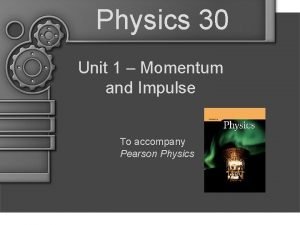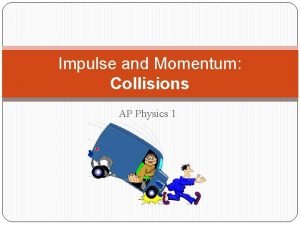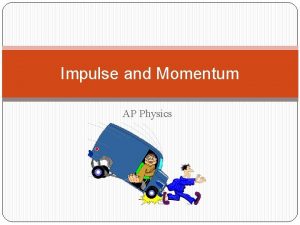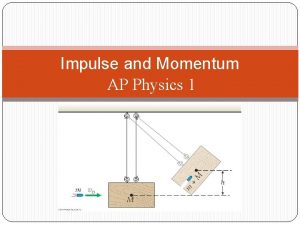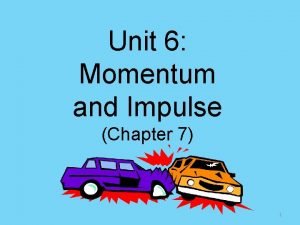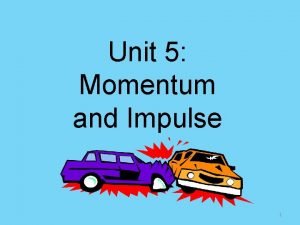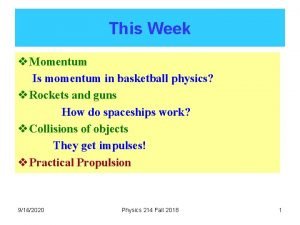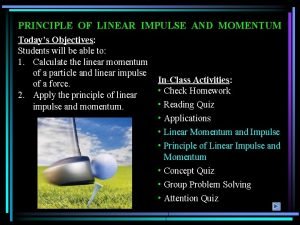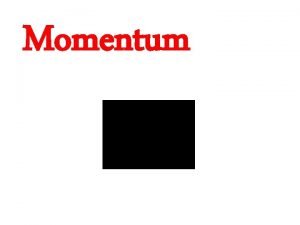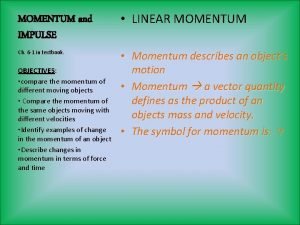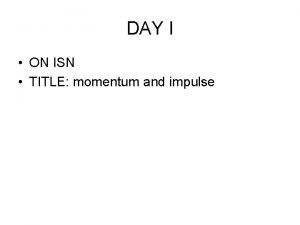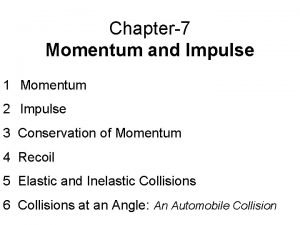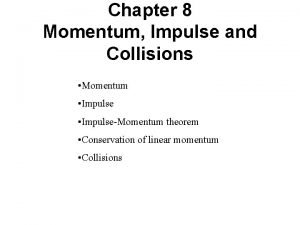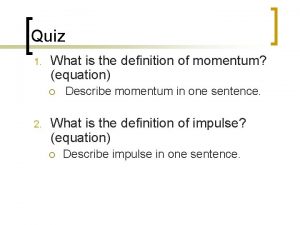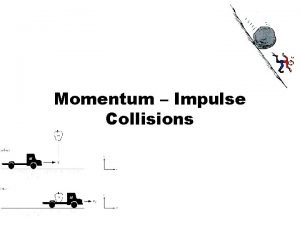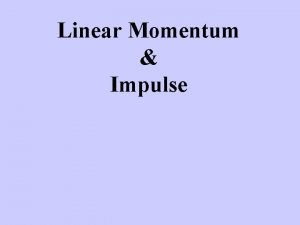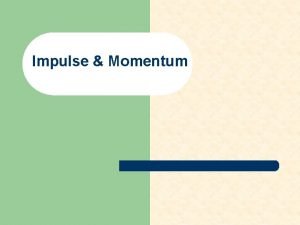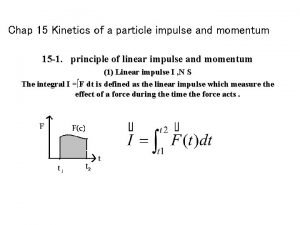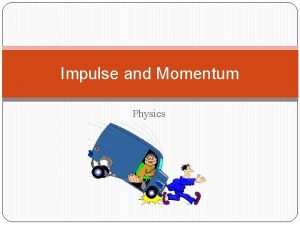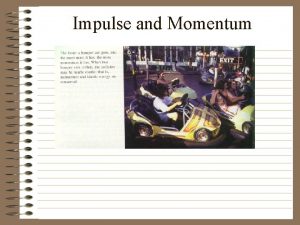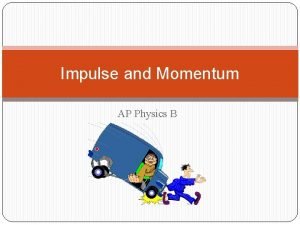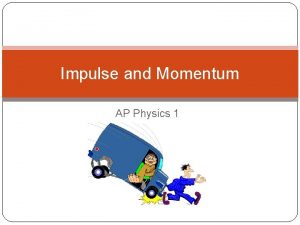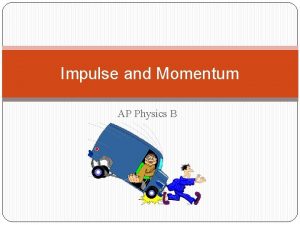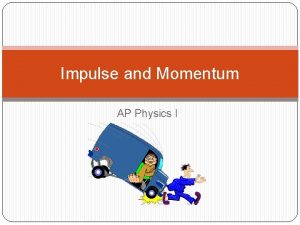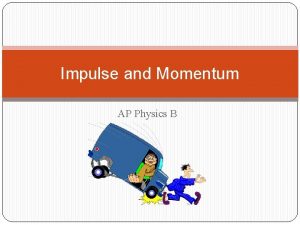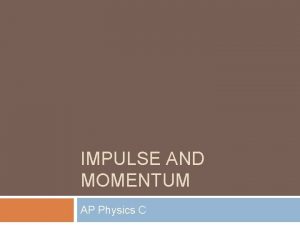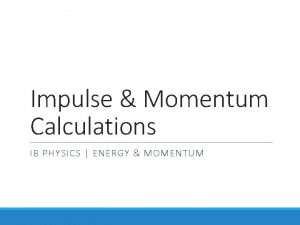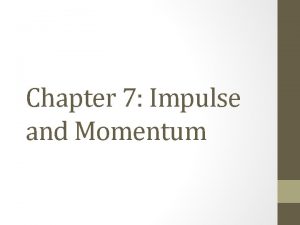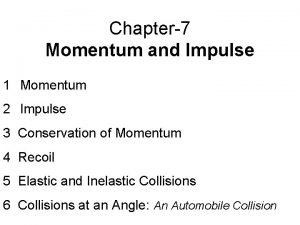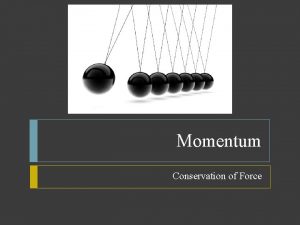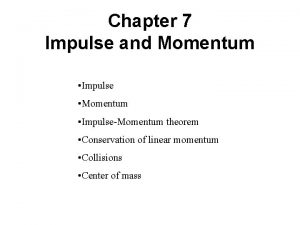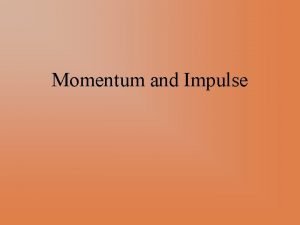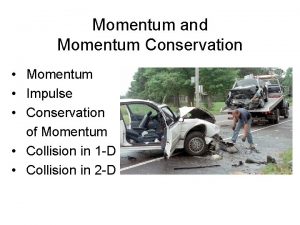Momentum Impulse AP Physics Impulse and Momentum Newtons























- Slides: 23

Momentum & Impulse AP Physics

Impulse and Momentum Newton’s 2 nd Law of motion can be rewritten by using the definition of acceleration as the change in velocity over the change in time.

Impulse and Momentum If the change in time is multiplied out of the denominator, we are left with the following:

The product of force and change in time is called the impulse (symbol is J). Impulse is a vector quantity and is measured in Newton-seconds (Ns).

Impulse If a car hits a haystack or the same car hits a wall, momentum is decreased by same impulse – the same products of force and time. However, impact force is greater into the wall than it is into the haystack as the haystack extends impact time, lessening the impact force. Impact time is the time during which momentum is brought to zero.

The product of the mass and the velocity is called the momentum (symbol -“rho”) of an object. Momentum is also a vector quantity and is measured in kgm/s. Note that the units for impulse and momentum appear different, but they are actually the same unit when simplified.

Momentum can be increased with an increase in either mass or in velocity or both. Ex: a rolling bowling ball has greater momentum than a tennis ball rolling at the same speed because its mass is greater Ex: a racecar going forward at 120 mi/hr has greater momentum than the same size car going 90 mi/hr due to its greater velocity If an object is not moving (no matter how big it is), the momentum is equal to zero.

The impulse-momentum theorem states that the impulse on an object is equal to the object’s final momentum minus the object’s initial momentum. Can also be written as:

Example 1

Example 2 A car of mass m, traveling at speed v, stops in time t when maximum braking force is applied. Assuming thebraking force is independent of mass, what time would be required to stop a car of mass 2 m traveling at speed v? (A) ½ t (B) t (C) √ 2 t (D) 2 t

Conservation of Momentum A system is the environment and all of the objects examined in a problem. A closed system is a system in which no mass is gained or lost. An isolated system is a system in which the net external force is zero… no forces acting outside of the system have an effect inside of it.

Conservation of Momentum The law of conservation of momentum states that the sum of momentum of any closed, isolated system does not change… or that the sum of the momentum of the objects in that system is constant.

Conservation of Momentum Mathematically, we can view this as a BEFORE and AFTER situation. For any two objects A and B:

Types of Collisions If two objects bounce apart when they collide and KE is NOT conserved, it is called an inelastic collision and can be written: If two objects bounce apart when they collide and KE is conserved, it is called an elastic collision and can be written: If two objects stick together when they collide and KE is NOT conserved, it is called an perfectly inelastic collision and can be written:

More on collisions Momentum is conserved in all three types of collisions. Kinetic energy is only conserved in an elastic collision. In inelastic and perfectly inelastic collisions, some of the KE converts into internal elastic PE, sound or heat. Collision Momentum KE End Result elastic conserved objects bounce inelastic conserved not conserved objects bounce perfectly inelastic conserved not conserved objects stick

Example 1 Tubby and his twin brother Chubby have a combined mass of 200. 0 kg and are zooming along in a 100. 0 kg amusement park bumper car at 10. 0 m/s. They bump Melinda’s car, which is sitting still. Melinda has a mass of 25. 0 kg. After the elastic collision, the twins continue ahead with a speed of 4. 12 m/s. How fast is Melinda’s car bumped across the floor?

Example 1 Picture Before Collision T&C Mel After Collision T&C Mel

Example 1 Answer

Example 1 Answer

Example 2 If an 800. kg sports car slows to 13. 0 m/s to check out an accident scene and the 1200. kg pick-up truck behind him continues traveling at 25. 0 m/s, with what velocity will the two move if they lock bumpers after a rear-end collision?

Example 2 Picture Before Collision After Collision

Example 2 Answer

Example 2 Answer
 Physics 03-02 potential energy and conservative forces
Physics 03-02 potential energy and conservative forces Physics 30 momentum and impulse unit exam
Physics 30 momentum and impulse unit exam Impulse symbol
Impulse symbol Ap physics 1 momentum and impulse
Ap physics 1 momentum and impulse Implusive force
Implusive force What is momentum in physics
What is momentum in physics Unit 6 momentum and impulse
Unit 6 momentum and impulse Unit of momentum and impulse
Unit of momentum and impulse How to find initial momentum
How to find initial momentum Principle of linear impulse and momentum
Principle of linear impulse and momentum Linear impulse and momentum
Linear impulse and momentum The importance of momentum
The importance of momentum Momentum and impulse poem
Momentum and impulse poem Which has a greater momentum a truck with a mass of 2250 kg
Which has a greater momentum a truck with a mass of 2250 kg Importance of momentum and impulse
Importance of momentum and impulse Momentum and impulse formula sheet
Momentum and impulse formula sheet Si unit of impulse
Si unit of impulse Units momentum
Units momentum Definition of momentum
Definition of momentum Momentum
Momentum Si unit of momentum
Si unit of momentum What has momentum
What has momentum Impulse and momentum
Impulse and momentum Kinetics of a particle: impulse and momentum
Kinetics of a particle: impulse and momentum

